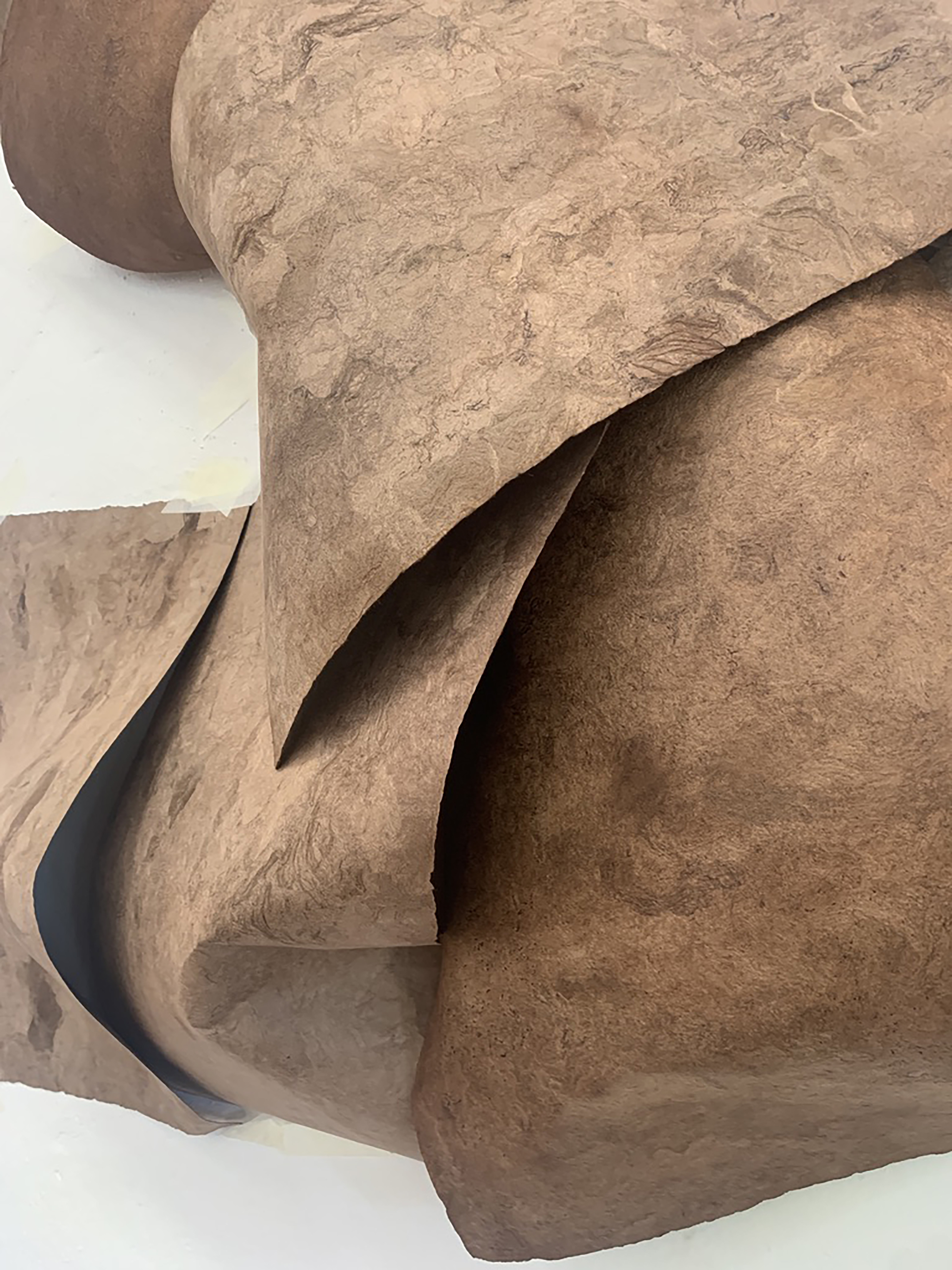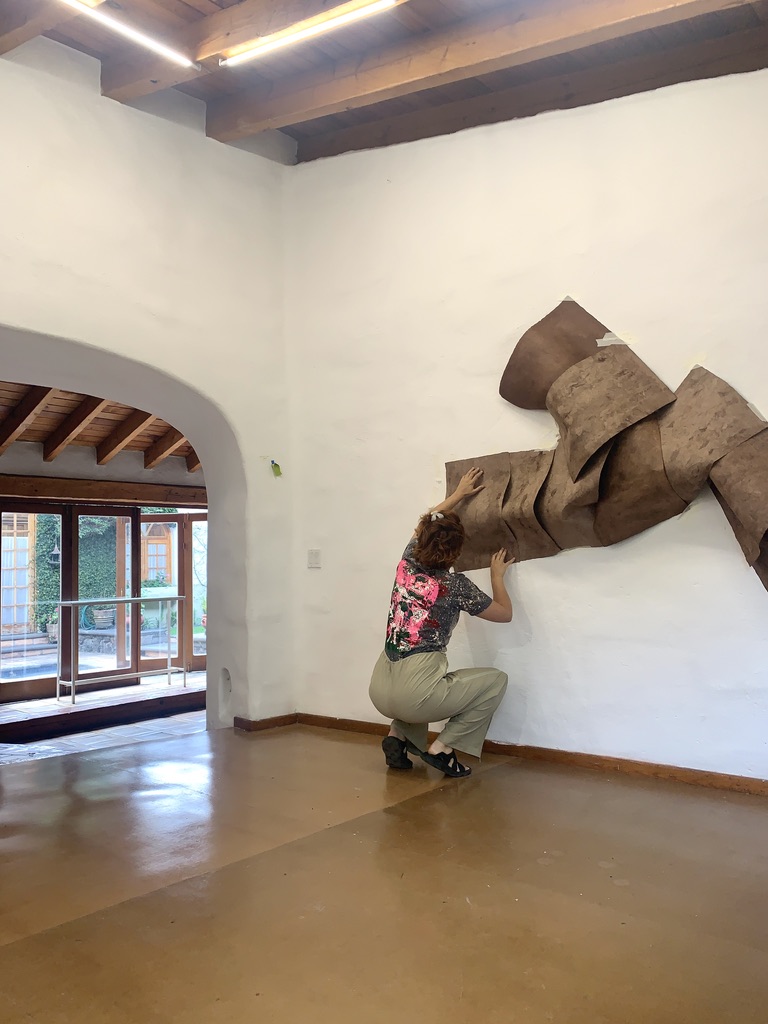Escondite para pájaros, 2023.
Sala Amadis INJUVE 2022/23 & Tandem-Ribera Irún
& Residencia Artística El Sur – Ciudad de México
Texto de Claudia Elies
El relato de "Escondite para pájaros" se construye como está hecho desde el cuerpo y el lugar. Hace lo que dice. Se articula como imagino que lo hacen las memorias personales donde todos los recuerdos, las intuiciones, los pensamientos, las memorias futuras se acumulan como pájaros en bandadas que construyen formas en el cielo. Como las montañas de gigabytes que se mueven por la red y que van de México hasta Euskadi, y pueden recorrer caminos sin concordancia, ni lógica, ni temporalidad. Que se mueven en un modo etéreo donde un cantar permite ser sentido. Un cantar que nunca es el mismo, que nunca sucede igual.
[eng]
Text by Claudia Elies
The story of 'Bird Hide' is constructed from the body and the place. It articulates personal memories, where intuitions, thoughts, and future memories accumulate like birds in flocks that build shapes in the sky. Similarly, mountains of gigabytes move through the net from Mexico to Euskadi, following paths without concordance, logic, or temporality. A song can be felt in an ethereal way, never repeating itself in the same manner.

Instrument created in collaboration with Juan Guti Vera, as part of the Art & Technology Research Grant TANDEM IRUN 2023.
Se propagarán sin retorno ni distancia, Cur. Blanca del Río & Display Burr Studio.
Sala Amadis INJUVE 2022/23 – Madrid
Photos by Maru Serrano


Sound Sculpture “El aire fluye al agua”, 2023. Music Juan Diego Calzada. Instrument with Juan Guti Vera. Sound sculpture: Speaker and glass 40x10x10 cm.


STATEMENT ARTISTA, Irati Inoriza
El aire fluye al agua, 2023.
Suena un silbido en la sala. Reacciono girando mi cabeza con la intención de encontrar el cuerpo que ha emitido ese sonido. Cuando todavía no he llegado a descubrirlo, suena otro silbido en otro lado. Cambio de rumbo con la intención de descubrir los cuerpos que emiten ese sonido. Observo las columnas de la exposición, y tomo consciencia de que hay varias hendiduras en ellas, vacíos por donde fluir.
Los vacíos originados en las columnas son un gesto para que la arquitectura de la sala se vincule a la escultura sonora propuesta. Utilizo esos vacíos para generar espacios de onda al sonido. Hay tres columnas con vaciados diferentes, tanto en forma, como en tamaño, y a niveles de altura distintos. Pensé en las diversas maneras en que el sonido emergiese de cada una de las columnas, para propagarse después por la sala expositiva. Un ejercicio donde cuerpo y vacío se vinculan convirtiéndose en, escondite.
El sonido sale de tres altavoces intervenidos con piezas de cristal, situados cada uno en una columna diferente de la sala expositiva. El diseño sonoro, realizado junto a Juan Diego Calzada, partiendo del instrumento proyectado junto al ingeniero Juan Guti Vera, dispone de composiciones de 5, 7 y 9 minutos. Los sonidos no están sincronizados. La idea es que cada persona, al entrar en la sala expositiva, tenga una experiencia sonora diferente. Cómo cuando abres un recuerdo. Fluye así el aire al agua.
[eng]
A whistling sound can be heard in the room. As I continue to search, I hear another whistling sound coming from a different direction. I turn my head to locate the source of the sound. I redirect my attention to locate the source of the new sound. Upon observing the columns of the exhibition, I notice several cracks in them, which create voids for the sound to flow through.
The voids within the columns serve to connect the architecture of the room with the proposed sound sculpture. These voids are used to create spaces for sound waves. There are three columns with varying void shapes, sizes, and heights. I considered the different ways in which sound could emanate from each column and spread throughout the exhibition hall. This exercise links the body and void, creating a hiding place.
The exhibition hall features three loudspeakers, each integrated with pieces of glass and located in separate columns. The sound design, created in collaboration with Juan Diego Calzada and based on an instrument developed with engineer Juan Guti Vera, includes compositions lasting 5, 7, and 9 minutes. The sounds are intentionally unsynchronized to provide visitors with a unique auditory experience upon entering the exhibition hall, similar to opening a souvenir. Additionally, the text mentions that the air flows into the water, which could benefit from further clarification.

TANDEM-RIBERA Irún, 2023
Art & Technology Research Grant
Kristaldutako Gorputzetan with Juan Guti Vera Mechatronic Engineering
El 23 de septiembre de 2023 presentamos el resultado de nuestra investigación de nueve meses: un híbrido entre arte y tecnología, que fusiona la naturaleza y la cultura en el entorno del río Bidasoa. Este proyecto, concebido como una suerte de orquesta de artefactos, se erige como un testimonio de nuestra exploración minuciosa de las vasijas silbadoras, inspirándonos para desarrollar un diseño único que se integra armoniosamente en el paisaje fluvial, respetando la interacción vital del río con el ecosistema de Irún.
Nuestra inmersión en la vida cotidiana de Irún desempeñó un papel fundamental en la gestación de esta idea. La observación y el asombro ante las aves que pueblan la zona fronteriza, libres y en sintonía con su entorno, nos condujeron a replantear nuestra investigación plástica y a adoptar el comportamiento simbólico de estos seres al convivir entre el agua y el aire sin fronteras territoriales. Fue este profundo vínculo con la naturaleza circundante lo que nos inspiró a crear un instrumento que evocara el canto de los pájaros, mientras se integraba armónicamente con dos elementos fundamentales del ecosistema del Bidasoa: el agua y el aire.
Las vasijas que diseñamos fueron concebidas para moverse y, por ende, emitir un sonido similar a un silbido, a un canto, gracias a la corriente del agua y a diversos mecanismos que instalamos. Estos artefactos, inspirados en las vasijas silbadoras tradicionales, aprovechan el principio de que el agua dentro de la vasija al moverse, presiona el aire dentro de la concavidad de la vasija, y empuja a este último a salir, produciendo así un sonido característico que se convierte en parte de la melodía del hábitat. Estos instrumentos se realizaron en impresión 3D con resinas vegetales.
Para nosotros, esta instalación no solo representa un gesto hacia la realidad contemporánea. En un contexto donde la atención a lo natural es imperativa, abogamos por un enfoque feminista que reconozca la importancia de esta conexión, al tiempo que cuestionamos las limitaciones culturales que nos han sido impuestas. En última instancia, nuestro trabajo aspira a fomentar una reflexión profunda sobre nuestra relación con el entorno y a promover una convivencia más armónica entre la humanidad y la naturaleza.
[eng]
On 23 September 2023, we will present the result of our nine-month research: a hybrid of art and technology that blends nature and culture in the Bidasoa River environment. This project is like an orchestra of artefacts and is a testament to our thorough exploration of whistling vessels. It has inspired us to develop a unique design that integrates harmoniously into the river landscape, respecting the vital interaction of the river with the ecosystem of Irún.
Our immersion in daily life in Irún was fundamental in developing this idea. Observing and being amazed by the birds that populate the border area, free and in tune with their environment, led us to rethink our artistic research and adopt the symbolic behaviour of these beings as they coexist between water and air without territorial borders. Our inspiration for creating a musical instrument came from the deep connection with the surrounding nature. We aimed to evoke the birds' song while seamlessly integrating with the two fundamental elements of the Bidasoa ecosystem: water and air.
The pots we designed were created to move and emit a sound similar to whistling or singing, thanks to the flow of water and various mechanisms we installed. These artefacts, inspired by traditional whistling pots, take advantage of the principle that the water inside the pot, as it moves, presses the air inside the concavity of the pot and pushes the air out, producing a characteristic sound that becomes part of the habitat's melody. These instruments were 3D printed using vegetable resins.
This installation represents more than just a nod to contemporary reality. In a world where environmental awareness is crucial, we promote a feminist approach that acknowledges the significance of this relationship while challenging the cultural constraints that have been placed upon us. Ultimately, our goal is to promote deep reflection on our relationship with the environment and encourage a more harmonious coexistence between humanity and nature.



3D printing plant resin, glass and float in Bidasoa River (Irun)
ESCONDITE PARA PÁJAROS, 2023
Artistic Residency in El Sur – Ciudad de México
Se esconde el pájaro.
No anima, se refugia.
Se adapta a la supervivencia.
Recorre el espacio, como lo hace el tiempo en su cuerpo.
Se posa.
A veces llama, a veces grita, a veces murmura, tararea …
Para qué silbar.
Donde se queda la tierra de la que fue parte.
Esconderse es buscar una alternativa, un lugar donde sentirse protegido.
[eng]
The bird hides.
It doesn't build a nest, it takes refuge.
It adapts to survival.
It travels through space, as time does in its body.
It perches.
Sometimes it calls, sometimes it screams, sometimes it murmurs, hums ...
Why whistle?
Where it keeps the land it came from.
To hide is to look for an alternative, a place to feel protected.


Studio work in El Sur Artistic Residency, august 2023.
Grant from INJUVE MOVIBILIDAD 2022/23 & Etxepare 2023.
Amate paper, glass and sound installation.


STATEMENT ARTISTA, Irati Inoriza
Escondite para pájaros, 2023.
En el estudio, atenta a lo que me rodea, pienso en lo que me ha traído aquí, hasta Ciudad de México. Un vuelo individual, que es eco. Eco de un vuelo colectivo que ocurrió hace tiempo y que es parte de una memoria colectiva de la que soy parte. ¿Cómo se queda en el cuerpo un recuerdo? ¿Y una memoria colectiva?
La memoria colectiva genera historia. Historia que es escrita por cuerpos en movimiento. Y los cuerpos se mueven en el espacio buscando refugio. Refugio que muchas veces no es nido, es escondite. Pero se anida.
Cuando doblas un papel, generas un espacio donde habitar. A la vez que juntas dos puntos que estaban muy lejos uno del otro. Pienso en cómo generar un espacio siendo más importante el recorrido que la forma. Ha sido un proceso de pensar la escultura desde el negativo de esta. Articulo este volumen convexo, desde la superposición de papeles hechos con cortezas de árbol. Una forma que se pone en diálogo con el jardín y las aves del estudio. Donde la materia es el foco y el vacío un escondite para pájaros.
[eng]
In the studio, I am attentive to my surroundings and reflect on what has brought me to Mexico City. It is an individual journey that echoes a collective flight from the past, which is now part of our shared memory.
I wonder how memories stay in our bodies, especially collective ones that shape our history. History is often written by those in motion, seeking refuge in spaces that may not be nests but rather hiding places that eventually become nests.
Folding a piece of paper creates a space to inhabit and connects two distant points. I consider how to create a space where the journey is prioritised over the appearance. Sculpting has involved conceptualising the form from its negative space. I have constructed this convex shape by layering papers crafted from tree bark. The resulting form interacts with the garden and the birds in the studio. Materiality is emphasised, and negative space provides a sanctuary for birds.
With the support of Ayudas a la creación INJUVE and Etxepare

